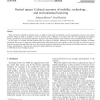Free Online Productivity Tools
i2Speak
i2Symbol
i2OCR
iTex2Img
iWeb2Print
iWeb2Shot
i2Type
iPdf2Split
iPdf2Merge
i2Bopomofo
i2Arabic
i2Style
i2Image
i2PDF
iLatex2Rtf
Sci2ools
IJMMS
2008
2008
Storied spaces: Cultural accounts of mobility, technology, and environmental knowing
When we think of mobility in technical terms, we think of topics such as bandwidth, resource management, location, and wireless networks. When we think of mobility in social or cultural terms, a different set of topics come into view: pilgrimage and religious practice, globalization and economic disparities, migration and cultural identity, daily commutes and the suburbanization of cities. In this paper, we examine the links between these two aspects of mobility. Drawing on non-technological examples of cultural encounters with space, we argue that mobile information technologies do not just operate in space, but they are tools that serve to structure the spaces through which they move. We use recent projects to illustrate how three concerns with mobility and space--legibility, literacy, and legitimacy--open up new avenues for design exploration and analysis. r 2008 Elsevier Ltd. All rights reserved.
| Added | 12 Dec 2010 |
| Updated | 12 Dec 2010 |
| Type | Journal |
| Year | 2008 |
| Where | IJMMS |
| Authors | Johanna Brewer, Paul Dourish |
Comments (0)

